Competitive and cooperative arm rehabilitation games played by a patient and unimpaired person: effects on motivation and exercise intensity
- PMID: 28330504
- PMCID: PMC5363008
- DOI: 10.1186/s12984-017-0231-4
Competitive and cooperative arm rehabilitation games played by a patient and unimpaired person: effects on motivation and exercise intensity
Abstract
Background: People with chronic arm impairment should exercise intensely to regain their abilities, but frequently lack motivation, leading to poor rehabilitation outcome. One promising way to increase motivation is through interpersonal rehabilitation games, which allow patients to compete or cooperate together with other people. However, such games have mainly been evaluated with unimpaired subjects, and little is known about how they affect motivation and exercise intensity in people with chronic arm impairment.
Methods: We designed four different arm rehabilitation games that are played by a person with arm impairment and their unimpaired friend, relative or occupational therapist. One is a competitive game (both people compete against each other), two are cooperative games (both people work together against the computer) and one is a single-player game (played only by the impaired person against the computer). The games were played by 29 participants with chronic arm impairment, of which 19 were accompanied by their friend or relative and 10 were accompanied by their occupational therapist. Each participant played all four games within a single session. Participants' subjective experience was quantified using the Intrinsic Motivation Inventory questionnaire after each game, as well as a final questionnaire about game preferences. Their exercise intensity was quantified using wearable inertial sensors that measured hand velocity in each game.
Results: Of the 29 impaired participants, 12 chose the competitive game as their favorite, 12 chose a cooperative game, and 5 preferred to exercise alone. Participants who chose the competitive game as their favorite showed increased motivation and exercise intensity in that game compared to other games. Participants who chose a cooperative game as their favorite also showed increased motivation in cooperative games, but not increased exercise intensity.
Conclusions: Since both motivation and intensity are positively correlated with rehabilitation outcome, competitive games have high potential to lead to functional improvement and increased quality of life for patients compared to conventional rehabilitation exercises. Cooperative games do not increase exercise intensity, but could still increase motivation of patients who do not enjoy competition. However, such games need to be tested in longer, multisession studies to determine whether the observed increases in motivation and exercise intensity persist over a longer period of time and whether they positively affect rehabilitation outcome.
Trial registration: The study is not a clinical trial. While human subjects are involved, they participate in a single-session evaluation of a rehabilitation game rather than a full rehabilitation intervention, and no health outcomes are examined.
Keywords: Exercise intensity; Interpersonal rehabilitation games; Motivation; Multiplayer games; Rehabilitation; Social interaction; Virtual reality.
Figures
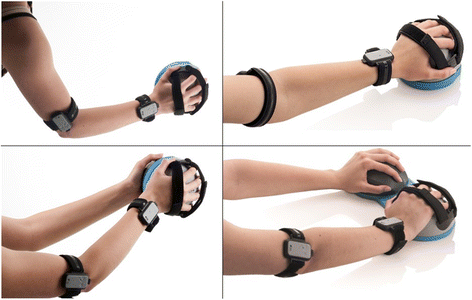

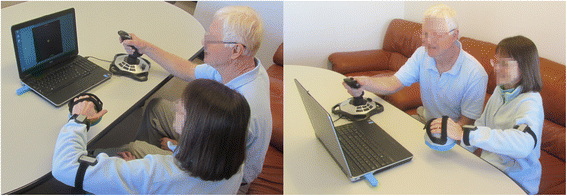
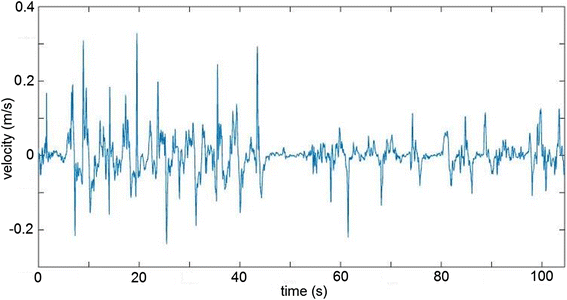

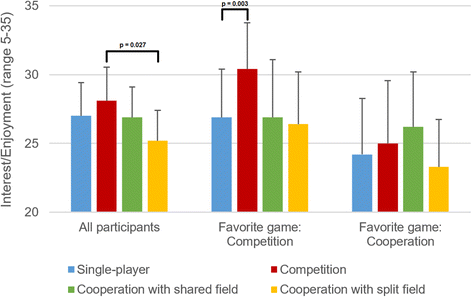
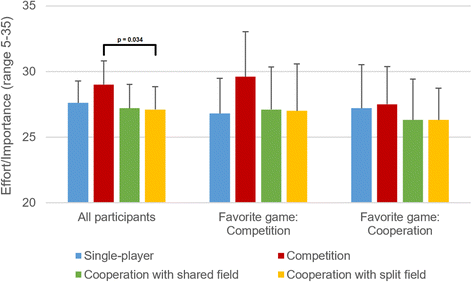
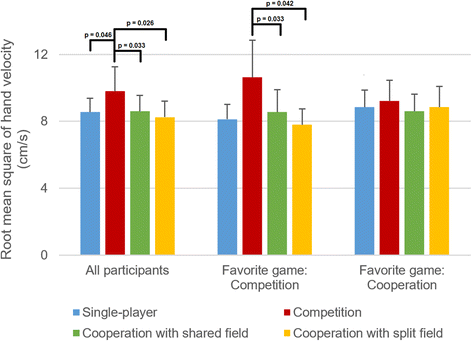
Similar articles
-
Trends in robot-assisted and virtual reality-assisted neuromuscular therapy: a systematic review of health-related multiplayer games.J Neuroeng Rehabil. 2018 Nov 19;15(1):107. doi: 10.1186/s12984-018-0449-9. J Neuroeng Rehabil. 2018. PMID: 30454009 Free PMC article.
-
A multisession evaluation of an adaptive competitive arm rehabilitation game.J Neuroeng Rehabil. 2017 Dec 6;14(1):128. doi: 10.1186/s12984-017-0336-9. J Neuroeng Rehabil. 2017. PMID: 29208017 Free PMC article.
-
Increasing motivation in robot-aided arm rehabilitation with competitive and cooperative gameplay.J Neuroeng Rehabil. 2014 Apr 16;11:64. doi: 10.1186/1743-0003-11-64. J Neuroeng Rehabil. 2014. PMID: 24739255 Free PMC article.
-
Design and pilot evaluation of competitive and cooperative exercise games for arm rehabilitation at home.Annu Int Conf IEEE Eng Med Biol Soc. 2016 Aug;2016:4690-4694. doi: 10.1109/EMBC.2016.7591774. Annu Int Conf IEEE Eng Med Biol Soc. 2016. PMID: 28269319 Free PMC article.
-
Effects of Different Opponent Types on Motivation and Exercise Intensity in a Competitive Arm Exercise Game.Games Health J. 2020 Feb;9(1):31-36. doi: 10.1089/g4h.2019.0028. Epub 2019 Oct 31. Games Health J. 2020. PMID: 31670574 Free PMC article. Review.
Cited by
-
Virtual reality-based treatment for regaining upper extremity function induces cortex grey matter changes in persons with acquired brain injury.J Neuroeng Rehabil. 2020 Sep 12;17(1):127. doi: 10.1186/s12984-020-00754-7. J Neuroeng Rehabil. 2020. PMID: 32919473 Free PMC article. Clinical Trial.
-
The size and behavior of virtual objects have influence on functional exercise and motivation of persons with multiple sclerosis: a randomized study.Sci Rep. 2022 Nov 12;12(1):19375. doi: 10.1038/s41598-022-24046-3. Sci Rep. 2022. PMID: 36371421 Free PMC article. Clinical Trial.
-
The use of game modes to promote engagement and social involvement in multi-user serious games: a within-person randomized trial with stroke survivors.J Neuroeng Rehabil. 2021 Apr 14;18(1):62. doi: 10.1186/s12984-021-00853-z. J Neuroeng Rehabil. 2021. PMID: 33853609 Free PMC article. Clinical Trial.
-
Trends in robot-assisted and virtual reality-assisted neuromuscular therapy: a systematic review of health-related multiplayer games.J Neuroeng Rehabil. 2018 Nov 19;15(1):107. doi: 10.1186/s12984-018-0449-9. J Neuroeng Rehabil. 2018. PMID: 30454009 Free PMC article.
-
A Brief Measure of Interpersonal Interaction for 2-Player Serious Games: Questionnaire Validation.JMIR Serious Games. 2019 Jul 23;7(3):e12788. doi: 10.2196/12788. JMIR Serious Games. 2019. PMID: 31339107 Free PMC article.
References
-
- Lloyd-Jones D, Adams R, Carnethon M, De Simone G, Ferguson TB, Flegal K, Ford E, Furie K, Go A, Greenlund K, et al. Heart disease and stroke statistics–2009 update: A report from the American Heart Association Statistics Committee and Stroke Statistics Subcommittee. Circulation. 2009;119:e21. doi: 10.1161/CIRCULATIONAHA.108.191261. - DOI - PubMed
-
- De Wit L, Putman K, Dejaeger E, Baert I, Berman P, Bogaerts K, Brinkmann N, Connell L, Feys H, Jenni W, Kaske C, Lesaffre E, Leys M, Lincoln N, Louckx F, Schuback B, Schupp W, Smith B, De Weerdt W. Use of time by stroke patients: a comparison of four European rehabilitation centers. Stroke. 2005;36:1977–1983. doi: 10.1161/01.STR.0000177871.59003.e3. - DOI - PubMed
Publication types
MeSH terms
Grants and funding
LinkOut - more resources
Full Text Sources
Other Literature Sources

